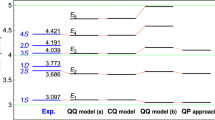Summary
The light-cone expansion of the commutators of bilocal currents is investigated in the relativistic oscillator quark model proposed by Feynman, Kislinger and Ravndal. An infinite-component field theory formalism describing the oscillator bound states of quarks is introduced in order to define the current operators. The calculation of the lightcone expansions of current commutators shown taht the elastic binding force, aeting between the quarks, does not affect the light-cone behaviour, which remains the same as in the free-quark model. The explicit forms of the deep inelastic structure functionsW 1,W 2 are also calculated in the free infinite-component field theory model with an arbitrary numberN of oscillating quarks (N=2: mesons,N=3: baryons,N>3: exotics). The scaling limits of the structure functions are sums of δ-function terms coming from the individual quarks even if the instability of excited states is taken into account by giving the trajectory an imaginary part. This indicates that nontrivial scaling functions are possible only in a model which accounts better for strong interactions.
Riassunto
Si studia lo sviluppo dei commutatori delle correnti bilocali nel cono di luce nel modello oscillatorio relativistico a quark proposto da Feynman, Kislinger e Ravndal. Si introduce un formalismo di teoria di campo ad infiniti componenti che descrive gli stati oscillatori legati allo scopo di definire gli operatori di correnre. Il calcolo dello sviluppo dei commutatori di corrente nel cono di luce mostra che la forza di legame elastica, che agisce fra i quark, non influisce sul comportamento del cono di luce, che rimane lo stesso che nel modello a quark liberi. Si calcolano anche le forme esplicite delle funzioni di struttura anelastica profondaW 1,W 2 nel modello di teoria di campo libero ad infinite componenti con un numero arbitrario di quark oscillanti (N=2: mesoni,N=3: barioni,N>3: esotici). I limiti di scala delle funzioni di struttura sono somme di termini di funzioni δ provenienti dai singoli quark anche se si tiene conto dell’instabilità degli stati eccitati assegnando alla traiettoria una parte immaginaria. Questo indica che funzioni di scala non banali sono possibili solo in un modello che tenga meglio conto delle interazioni forti.
Реэюме
В релятивистской осцилляторной кварковой модели, предложенной Фейнманом, Кислинджером и Равндалом, исследуется раэложение на световом конусе коммутаторов билокальных токов. Чтобы определить операторы токов, вводится формалиэм теории поля с бесконечным числом компонент, описываюший осцилляторные свяэанные состояния кварков. Вычисление раэложений на световом конусе коммутаторов токов покаэывает, что упругая сила свяэи, действуюшая между кварками, не влияет на поведение на световом конусе, которое остается таким же, как в случае модели свободных кварков. Вычисляются явные выражения для глубоко неупругих структурных функцийW 1 иW 2 в модели свободной теории поля с бесконечным числом компонент с проиэвольным числомN осциллируюших кварков (N=2: меэоны,N=3: барионы,N>3: зкэотические частицы). Пределы подобия для структурных функций представляют суммы й-функционных членов, происходяших от индивидуальных кварков, даже если учитывается неустойчивость воэбужденных состояний эа счет введения мнимой части траектории. Это укаэывает на то, что нетривиальные функции подобия являются воэможными только в модели, которая лучще описывает сильные вэаимодействия.
Similar content being viewed by others
References
H. Fritzsch andM. Gell-Mann: Cal. Tech. preprint CALT-68-297 (1971), to be published inProceedings of the Coral Gables Conference on Fundamental Interactions at High Energy (Coral Gables, Fla., 1971).
J. M. Cornwall andR. Jackiw:Phys. Rev. D,4, 367 (1971).
R. Jackiw andG. Preparata:Phys. Rev. Lett.,22, 975 (1969);S. L. Adler andWu-Ki Tung:Phys. Rev. Lett.,22, 978 (1969).
D. J. Gross andS. B. Treiman:Phys. Rev. D,4, 1059 (1971).
R. P. Feynman, M. Kislinger andF. Ravndal:Phys. Rev. D,3, 2706 (1971).
H. Bébié, V. Gorgé andH. Leutwyler:Light-cone structure of infinite-component fields, University of Bern preprint (1971).
F. Ravndal: Cal. Tech. preprint, CALT-68-299 (1971);G. Domokos, S. Kovesi-Domokos andE. Schonberg:Phys. Rev. D,3, 1184, 1191 (1971).
H. Yukawa:Phys. Rev.,91, 415, 416 (1953).
See, for instance,P. N. Bogolubov: Dubna preprints P-2098, P-2186 (1965) (in Russian);K. Fujimura, T. Kobayashi andM. Namiki:Progr. Theor. Phys. (Kyoto),44, 193 (1970).
H. Leutyuler:Phys. Lett.,31 B, 514 (1970).
I. Montvay:Proper time formulation of the bound-state problem and models with linear trajectories, inLecture Given at the Karpacz Winter School, February 1971, and Budapest University preprint No. 288 (1971).
I. Montvay:Duality and the oscillator models of hadrons, inProceedings of the JINR-CERN School on High Energy Physics, Vana, June 1971, Vol. II. p. 208.
R. P. Feynman:Phys. Rev. Lett.,23, 1415 (1969);Proceedings of the III International Conference on High-Energy Collisions, Stony Brook, 1969 (New York, 1969), p. 237;J. D. Bjorken andE. A. Paschos:Phys. Rev.,185, 1975 (1969).
I. Montvay:The vector current in parton-oscillator models of hadrons, Budapest University preprint No. 291 (1971), unpublished.
C. G. Callan andD. J. Gross:Phys. Rev. Lett.,22, 156 (1969).
I. Montvay andA. Patkós:The role of the pomeron in correcting the exponential electromagnetic form factors in relativistic quark models, Budapest University preprint No. 303 (1971).
Author information
Authors and Affiliations
Rights and permissions
About this article
Cite this article
Montvay, I. Light-cone behaviour in the relativistic quark oscillator model. Nuov Cim A 11, 207–221 (1972). https://doi.org/10.1007/BF02722787
Received:
Published:
Issue Date:
DOI: https://doi.org/10.1007/BF02722787




